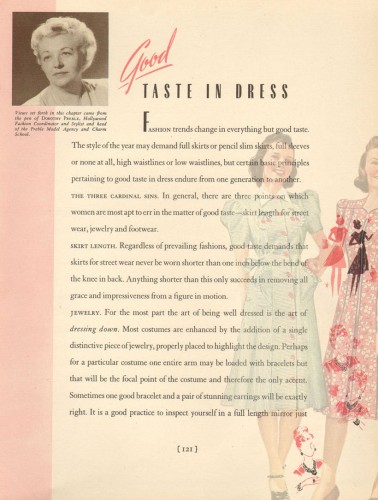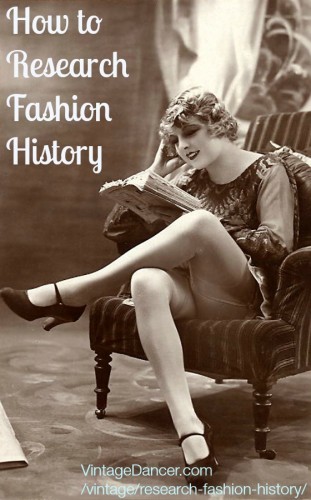
The internet has never been a great place for researching fashion history. While I am trying to change that with my own articles, VintageDancer.com is not intended to be a reference library. I do not cite most of my sources for this reason.
What I can do is help guide students and vintage fashion lovers to conduct their own research using my favorite resources and search techniques. The following are all the ways I have learned to research fashion history on and offline:
Books
The library: While today’s students start with a web search for information, back in my student days, we used the library. Books and magazines at the library are a great pace to start, and a better place to look than Amazon, because most are out of print.
Fashion history doesn’t change too much, so yesterday’s books are still useful to researching today. The closer the book publication date to the decade you are researching, the better the information, in my experience. An author who writes from her/his own memory is more in tune with fashion that was actually worn.
Be sure to look at not only general fashion history books, but books on specific sub topics such as lingerie or swimwear. The latter often have better, more detailed, information. General history books rarely cover everyday fashions, only major fashion designers or big fashion defining pop culture movements.
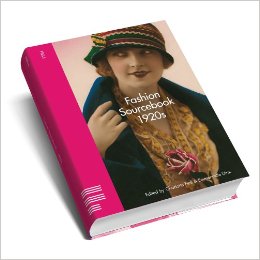
Books like this “1920’s Fashion Sourcebook” can be very useful to researching even if its mostly pictures like this one.
Looking at library books under “fashion history” or “costume history” is the most obvious place to start. After you have devoured those areas, take a look at general history books that may have chapters on fashion or just about life in general during the decade. I often find the most interesting information is in chapters on pop culture, advertising, TV, and movies.
Next, look at women’s history subjects. Sadly, men’s history books don’t usually cover clothing, but women’s usually does.
Finally, look at the “craft and sewing” or “beauty and makeup” section. Often there will be books with chapters on dress making history, textiles, or makeup history. When you have exhausted your local library’s collection, expand to other public libraries and university libraries. You don’t need a library card to look at most public and college libraries.
It is not a well known fact that most libraries can get any book at any library, around the world, as long as it has been in publication for at least 6 months. Many libraries offer this service for free or for a small cost. The book usually arrives to you in a week or so and you can keep it for just a few weeks. Use your library’s reference desk to find out how to search other libraries or use www.worldcat.org.
Google books also has a “find in library” search option that is helpful. Once you have the name of the book, author, and publisher, your library should be able to get the book for you.
Tip: When searching any library’s catalog, use the search feature “find nearby books” to get a better return than, say, looking only at results for “1920s fashion.”

Library of Books! Heaven for a researcher.
University or Private Libraries – Since university students are at school to learn and conduct research I find their libraries more helpful than local public libraries. They often have historic books, a bigger selection of books, catalogs, magazines (like Vogue) and other hard to find sources. Their reference desk is often (but not always) better trained in research too.
While you may or may not be able to get an account and check out books you can usually look at any book or magazine they have on site. Bring lots of cash to make photo copies to take home or use your camera phone to take pictures/scans of each page (or both!)
One of my favorite types of books to look at in a University library are Yearbooks. Talk about a photo journey back into fashion’s past! The images are very useful for seeing what students and faculty actually wore, and the head-shots are perfect for studying hair and makeup.
Museums – If you are lucky enough to live near a costume or textile museum, then you have a wealth of information most libraries won’t have. Museums collect books but also original magazines, newspaper articles, photographs, and especially local fashion history. Some general history museums will also have a collection on fashion too. Call and find out before stopping by. Often, these old records are viewable by appointment only.
Used book stores – Every so often, I browse through used book stores, thrift stores, antique malls, and online used book sellers to find cheap old books and magazines to buy. I have found vintage catalogs, fashion history books, and cultural history books that have all been useful to my research.
My latest find is a 1940s mail order “Beauty Course” that is full of advice on how to dress your figure type, apply makeup, exercise, and have good hygiene. The later two are not as useful as the first two, but they sure do make a funny read!
Beauty courses and booklets have great fashion information as well as textbooks. Back in the day, girls were taught classes in home economics that included buying clothing on a budget, recognizing types of materials, how to choose flattering styles, and what a typical wardrobe should include. These books are a goldmine of cultural and fashion history!
Textbooks on textile production can also be useful to understanding the types of materials referenced in catalogs that we have no understanding of what they mean today. What is lisle, for example.
Curious what books are in my collection?
My favorite online used book sellers:
Amazon – a great place to buy used copies of books. Not always the cheapest with shipping so look around and compare prices.
abebooks.com – My favorite source. Use the “search by publication date” feature to find books in your decade. When you find something, google the title, to be sure it’s not being sold elsewhere for less.
Better World Books – Another huge database of books for sale. They sell on Amazon, too, but you can go direct and save a few bucks.
Magazines, Newspapers
Outside of books, fashion history is best sourced in smaller publications. You can search databases of articles (both Academic/scholarly or general interest). Different libraries subscribe to different databases. Some you can access free online, some you have to login into the library system in person to search. Some only have article excerpts, while others have the full article. Those that only have the article excerpts can be requested, just like you can with ordering a book.
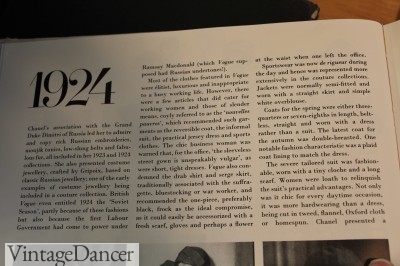
Photograph books and articles so you can remember what you read!
Searching articles is a beast of a process. I much rather search books, but given a few hours and using a lot of different search keywords, I often will find some great articles.
Keyword research is key to finding the best articles: Searching for “1920s fashion history” won’t yield many results or very good ones. Searching for “clothing,” “clothes,” “costume,” “wardrobe”, “dress”, “suits”, “hats” “beauty” etc. will give you better results, BUT you still need to narrow them down.
You can try adding the decade to the search ie “1920s” but also try “1921” “1922” “1923” etc. Articles will often include exact years, not general decades, especially in older documents. For original sources, try adjusting the publication year to the decade you are researching plus a few years. For 1920s, narrow your years to 1919-1932. Articles published shortly after the decade ends are usually about fashions of the recent past, not necessarily the publication year.
Besides keywords, you can search for specific publications. Vogue magazine, McCall’s Magazines, Women’s Daily, Ladies Home Journal, Women’s World, Harpers Bazar, Delineator, Pictorial Review, etc. For men try Apparel Arts, Clothier and Furnisher, Mens Wear, The Haberdasher, Boot and Shoe Review, and The Sir.
If you are familiar with publications in your decade of research, you can browse through all the articles within your decade and find the ones that pertain to fashion. Tedious, yes, but if you love the thrill of the hunt, it’s very fun!
Google Newspaper Archives– Useful database, searchable by text. Limited images
Google Books– Search full text books and magazines both old and new.
HathiTrust. org– Full of full text magazines, periodicals, books, catalogs etc
U of Wisconsin – Has a good online database of magazines
Internet Archive.org – Many magazines, some books. Hard to use the search feature.
Ancesty.com -Subscription required with free trail. The searchable text databases can look at newspapers, people name searches, catalogs, and much more, etc. The subscription is well worth the cost!
Catalogs, Images
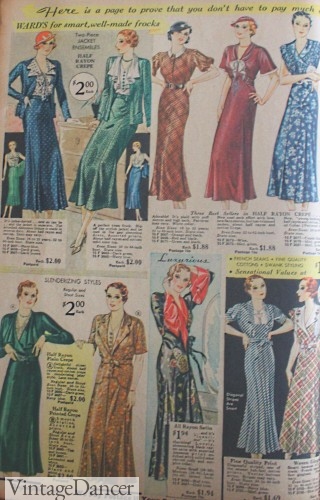
1933 Montgomery Wards Catalogs. The best source for everyday fashions!
If its wasn’t for vintage shopping catalogs, I don’t know if half of my articles would be as well researched. There is not a better source for real everyday clothing history than to look at catalogs. Sears and Montgomery Ward’s are the biggest name brands, but other retail stores, now out of business, are just as good (and cheaper to buy).
In my collection, I have catalogs from Belle Hess, Simpson’s, Alden’s, Eton’s, Charles Williams, and National’s. I am on the hunt for some Lane Bryant catalogs currently.
I buy my catalogs on eBay and Etsy. They are not cheap. $30-$60 is what I usually pay, Anything more and I just wait for another listing. If you don’t have the budget to buy catalogs, use your library or buy used copies on Amazon.com for the “Fashionable Clothing from Sears Catalogs” book series. While not an exhaustive reproduction of an entire catalog, they do contain scans of pages of many catalogs by “early” “mid ” and late” decade years. This is the primary source I recommend to students researching a difficult topic such as “teen clothing” or “beauty products.”
The Sears Wishbook collection has many Sears Christmas catalogs from the 1930s to 1970s.
Christmas.musetechnical.com Has old catalogs to view from 1940 to 2009.
Ancesty.com Has the entire Sears catalog collection from 1893 to 1993. Subscription required with free trail. The searchable text is very helpful as well as the other databases such as newspapers, people name searches, etc.
Vintage Ad Browser – Not a fashion catalog but a collection of old advertisements, organized by topic or date. Very helpful for researching beauty, makeup, vintage cars, home decor, and food.
Retro Musings (UK)- A large collections of images, ads, catalogs organized by topic or brand.
The Costumer’s Manifesto – A wonder source for old catalogs, books, patterns, sewing manuals, and historical costume illustrations.
Outdoor Recreation Catalogs & Magazines from Utah State University- Has a large collection of magazines and catalogs related to outdoor sports (hunting, hiking, climbing, running etc)
Library of Congress – I use the photo database to find old photos by date, place, sometimes subject. Most are out of copyright. Flicker Commons is another way to sear LOC and 100 other public online photo databases. Wikipedia too has out of copyright images.
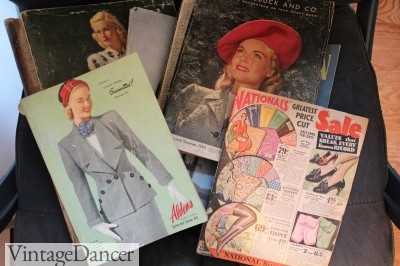
A few of my vintage catalogs
What catalogs are best for is women’s morning and afternoon dresses, lingerie, shoes, men’s work clothes, suit, shoes, and kids’ and teens’ clothes. What they lack are evening wear, wedding clothes, men’s hats, and specialty uniforms.
Some trendy clothes like Zoot Suits in the 1940s will also not be in catalogs. Menswear prior to the mid ’20s was also not well cataloged. Most men still went to their own tailors and haberdashers for clothing and hats. Menswear in catalogs sold underwear, shoes, and sport clothing.
For the few drawbacks catalogs have, they are still my life saver. At times when I can’t find good information elsewhere, I will write an entire article just on what is included in catalogs. I try to get at least one catalog from the early, middle and late years and compare them to see how fashions changed.
More than fashion history, the descriptions and “selling points” of the clothing will tell you a lot about names of styles, preferred materials, colors, and trim as well as “why” a consumer will want this dress or another. The 1920s was all about copying New York style, the 1930s on buying frugal, the 1940s on looking patriotic, 1950s on matching outfits, etc. Fascinating cultural history within an unlikely source!
Online Databases:
Despite the lack of good information that pops up in search results there are a number of good websites to find books and articles online:
HathiTrust – An amazing database of articles that are full-view (usually out of copyright) or record only. Some record only articles I was able to find online for free by searching for the title. My favorite sources are catalogs and magazines such as Delineator (1882-1907), Butterick, clothing trade periodicals, dressmaking trade periodicals, beauty periodicals and etiquette books.
Berg Fashion Library – This is a useful membership site for scholarly articles. The cost is reasonable for the amount of information you can get.
Project Gutenberg – Google’s project to digitize books in universities’ holdings. I have the worst time using the search feature, but occasionally you can find some great stuff. Try searching Books.Google.com too for your “keywords.” The search will bring up excerpts from books both in the Gutenberg collection as well as current books that publishers allow text searches. Google books do link to some sources where the book is for sale online or in a library, but I often find better results by searching the title and author in a web search. Scholar.google.com is a searchable database of articles written by professionals fashion historians. Many are free to download.
archive.org – Another goldmine of information, when you can find it. Not the easiest to search. It also only has books that are out of copyright which roughly means books prior to 1926. They have video and audio too which is fun to watch/listen.
National Museum of African American History and Culture – Is an excellent first stop to researching black history in America.
Harvard Library has An exploration of women’s impact on the economic life of the United States between 1800 and the Great Depression.
American Memory from the Library of Congress – When you need photos to illustrate your research, the Library of Congress is a good site. It’s a giant database of photos and historical documents that, although organized well, will still leave you searching page by page for the best images. You can narrow your search by date and topic, but after that, you might want to expand your search back to just topic for some photos you might have missed. I always find new images every time I search.
Some blogs are full of images, all out of copyright, with links back to the listing. Try Shorpy and SydneyFlapper (mostly 1920s/30s), Pond5 (small sizes are free.) Some sites like these have out of copyright photos: The Commons by Flickr (Most images are from the Library of Congress), NY Public Library, and New Old Stock.
What about the images on VintageDancer.com? Can you use them? Without going into the details of copyright law, I will say that I feel comfortable with the copyright status of the images on the website. Other than the ones I own (photos of myself or family) all others should be out of copyright. I would not suggest using them for a publication but personal use, small exhibits, school projects, should be ok. Because I do not claim to own the copyrights of these images, I can’t “give” you permission to use them.
If you need an image for a publication I recommend buying vintage photographs on etsy or ebay or using a photo resell service such as Shutterstock, Getty Images, Alamy
Fashion History Websites
I follow a few websites that focus on teaching or re-sharing fashion history. I am always seeking more so if you know of any not included here please leave a comment below:
fashion-era.com – A large collection of one fashion historian’s thoughts and sketches about all decades of women’s fashion history. A good place to start online.
wornthrough.com – An academic news source of whatever is going on in the academic fashion history world. I like their posts on new fashion history books and research papers available as well as fashion exhibits around the world.
blog.fidmmuseum.org/museum – Whatever the FIDM museum produces is worthy of following. Exhibits with matching exhibit books are excellent fashion history resources.
kickshawproductions.com/blog – Jonathan Walford is a fashion historian with a number of excellent books in publication. His blog is worth following for the few but very insightful articles he publishes.
witness2fashion.wordpress.com – My latest blog discovery is chalk full of fashion in detail of the 1920s and 1930s. I have learned a great deal from this website and you will too.
www.gentlemansgazette.com – THE site for everything about men’s traditional fashion. Many detailed articles on men’s clothing history as well as a giant book list of men’s fashion books (both history and current dressing advice).
twonerdyhistorygirls.blogspot.com – Once a week, these historical novel writers roundup links to some amazing history postings online. Not always about fashion, but fascinating non the less.
newvintagelady.blogspot.com – On Sunday is a roundup of catalogs scans from mostly the ’30s to the ’50s. Most are also women’s plus size fashions!
what-i-found.blogspot.com – A blog that showcases “found” sewing patterns, articles and advertisements. Very interesting finds.
thevintagetraveler.wordpress.com – This avid vintage collector specializes in sportswear and casual clothing. Her finds are always fascinating.
Books by the VintageDancer
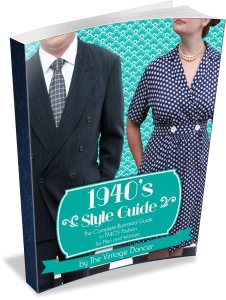
My first book was the 1940s Style Guide: The Complete Illustrated Guide to 1940s Fashion for Women and Men. It is still available as an eBook ($9.99) or printed book ($14.00). Since its first publication, I have put most of the chapters online and revised/updated them. You can read them in the 1940s Style Guide email series for free. I leave the book available for sale for those who want to carry a copy with them.
Phew! Well that’s about all I can say on researching fashion history. I am always learning new techniques so I will keep updating this article as I find new sources. Please share you tips and tricks in the comments below.
Debbie Sessions has been teaching fashion history and helping people dress for vintage themed events since 2009. She has turned a hobby into VintageDancer.com with hundreds of well researched articles and hand picked links to vintage inspired clothing online. She aims to make dressing accurately (or not) an affordable option for all. Oh, and she dances too.
